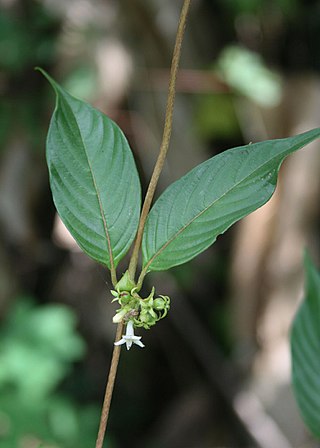
Amanoa is a genus from the family Phyllanthaceae first described as a genus in 1775. It is native to South America, Central America, the West Indies, and tropical Africa.

Hevea is a genus of flowering plants in the spurge family, Euphorbiaceae, with about ten members. It is also one of many names used commercially for the wood of the most economically important rubber tree, H. brasiliensis. The genus is native to tropical South America but is widely cultivated in other tropical countries and naturalized in several of them. It was first described in 1775.

Couroupita is a genus of flowering plants in the family Lecythidaceae first described as a genus in 1775. It is native to tropical South America and Central America.
- Couroupita guianensis - Cannonball tree -Guyana, Colombia, Ecuador east to Amapá and south to Bolivia; naturalized in the West Indies as well as in Bangladesh, Sri Lanka and Andaman & Nicobar
- Couroupita nicaraguarensis – Bala de cañón, coco de mono, paraíso, zapote de mico, or zapote de mono -Nicaragua, Costa Rica, Honduras, Panama
- Couroupita subsessilis - northern Brazil, northern Peru
Conceveiba is a plant genus of the family Euphorbiaceae, first described as a genus in 1775. It is native to South America and Central America.
- Conceveiba guianensisAubl. - Brazil, Peru, Bolivia, Ecuador, Colombia, Venezuela, 3 Guianas
- Conceveiba hostmaniiBenth. - Guyana, Suriname, Amazonas State in Brazil
- Conceveiba krukoffiiSteyerm. - Venezuela, French Guiana, NW Brazil
- Conceveiba latifoliaBenth. - Colombia, Venezuela, Peru, Amazonas State in Brazil
- Conceveiba martianaBaill. - Venezuela, French Guiana, NW Brazil, Colombia, Ecuador, Peru, Bolivia
- Conceveiba maynasensisSecco - Loreto in Peru
- Conceveiba parvifoliaMcPherson - Panama, NW Colombia
- Conceveiba pleiostemonaDonn.Sm. - Costa Rica, Nicaragua, Colombia, Venezuela
- Conceveiba praealta(Croizat) Punt ex J.Murillo - NW Brazil
- Conceveiba ptariana(Steyerm.) Jabl. - S Venezuela
- Conceveiba rhytidocarpaMüll.Arg. - Colombia, Ecuador, Peru
- Conceveiba santanderensisJ.Murillo - NW Colombia
- Conceveiba terminalis(Baill.) Müll.Arg. - Venezuela, Guyana, Suriname, NW Brazil, Colombia, Peru
- Conceveiba tristigmataJ.Murillo - Colombia, Venezuela, NW Brazil

Mabea is a plant genus of the family Euphorbiaceae first described in 1775. It is native to Central and South America as well as Mexico and Trinidad.

Maprounea is a plant genus of the family Euphorbiaceae first named as a genus in 1775. It is native to tropical Africa, Trinidad, and tropical Central and South America.
- Maprounea africana - W + C + S Africa, from Benin to Zimbabwe
- Maprounea amazonica - Colombia, Venezuela, N Brazil
- Maprounea brasiliensis - Brazil, Paraguay, Bolivia
- Maprounea guianensis - Trinidad, Panama, Colombia, Venezuela, French Guiana, Suriname, Guyana, Brazil, Peru, Ecuador, Bolivia, Paraguay
- Maprounea membranacea - Nigeria, Cameroon, Gabon, Equatorial Guinea, Cabinda, Central African Republic, Congo, Zaire

Jean Baptiste Christophore Fusée Aublet was a French pharmacist, botanist and one of the earliest botanical explorers in South America. He was one of the first botanists to study ethnobotany in the Neotropics.

Couratari is a genus of trees in the family Lecythidaceae, first described as a genus in 1775. They are native to tropical South America and Central America.

Acioa is a genus of plants in the family Chrysobalanaceae described as a genus in 1775. It is native to northeastern South America.
- Acioa barteri -
- Acioa edulis - Amazonas in Brazil
- Acioa guyanensis - French Guiana, N Brazil
- Acioa schultesii - SE Colombia, S Venezuela, NW Brazil
- Acioa somnolens - French Guiana, N Brazil

Guapira is a genus of Neotropical shrubs in four o'clock family. Its species are native to Mesoamerica, South America, the West Indies, and the extreme southern part of Florida.

Sabicea is a genus of flowering plants in the family Rubiaceae. They are known commonly as the woodvines. The type species is Sabicea cinerea. There are about 145 species. Most are distributed in tropical Africa and South America.

Couepia is a genus of flowering plants in the family Chrysobalanaceae described as a genus in 1775.

Heliconia psittacorum is a perennial herb native to the Caribbean and South America. It is considered native to French Guiana, Guyana, Suriname, Venezuela, Colombia, Bolivia, Brazil, Paraguay, Panama and Trinidad and Tobago. It is reportedly naturalized in Gambia, Thailand, Puerto Rico, Hispaniola, Jamaica and the Lesser Antilles. It is often cultivated as a tropical ornamental plant in regions outside its native range.
Pariana is a genus of tropical American plants in the grass family.

Carapichea is a genus of flowering plants in the family Rubiaceae. It is native to Central America and northern South America from Nicaragua to Brazil. One species, Carapichea ipecacuanha, is used medicinally as the source of ipecac, a powerful emetic.

Coutarea is a genus of flowering plants in the family Rubiaceae. The genus is native to southern Mexico, Central America, South America and the West Indies.

Spermacoce alata, the winged false buttonweed, is a species of plant in the Rubiaceae. It is widespread across the warmer parts of the Western Hemisphere and naturalized in many other parts of the world.

Rapatea is a group of plants in the family Rapateaceae described as a genus in 1775.

Mayaca fluviatilis, also known as bog moss, is a perennial herbaceous submerged plant in the monogeneric family Mayacaceae. It is native to Central and South America, the Caribbean, and the United States where it is often sold as an aquarium plant. Through the aquatic plant trade, it has recently become naturalized in Sri Lanka, Singapore, and China. It has been identified in three locations in Australia but more populations are likely in other parts of Australia as well.

Tibouchina aspera is a species of flowering plant in the family Melastomataceae, native to Central America and tropical South America. It was first described by Jean Fusée Aublet in 1775. In the original description of the species, it was suggested that the plant was inhaled to treat chest pain and dry coughs.

















